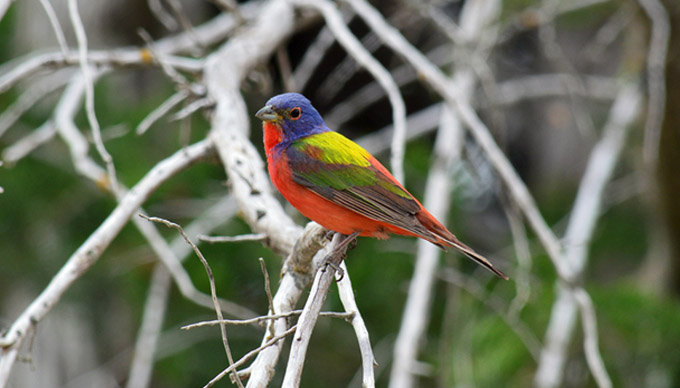The Texas Hill Country has a fascinating network of ecosystems, which includes limestone geology, clear streams and beautiful, spring-fed rivers. In the spring months, the wildflowers explode with color, signaling and optimal time for birding.
The Hill Country is home to approximately 430 bird species. Two of these are particularly interesting to birders: the Golden-cheeked Warbler and Black-capped Vireo. Both are on the endangered species list and highly protected, so catching a glimpse of these tiny birds is always a treat.
With observation platforms, enclosed shelters, and traditional birding blinds, these sites offer some of the best bird watching in The Hill Country.
1. Balcones Canyonlands National Wildlife Refuge – Marble Falls, TX
Photo: Flickr/Jason Crotty
The primary mission of Balcones Canyonlands is to protect the nesting habitats of the golden-cheeked warbler and black-capped vireo, which are endangered, migratory birds. Golden-cheeked warblers reside in Ashe juniper and oak woodlands of the refuge and are the only bird species that nest exclusively in Texas. The savannahs of the refuge provide the brushy tickets crucial to the black-capped vireo. Additionally, the refuge is home to a myriad other species including spoonbills, hawks, eagles, ducks and geese, falcons, turkeys, and many more.
Balcones Canyonlands is one of only 14 designated refuges where professionals, such as land managers, go to learn about cutting-edge habitat management techniques and technology.
Photo: Flickr/HarmonyonPlanetEarth
Fredericksburg is located in the heart of the Texas Hill Country, so it is an optimal birding location. It is also home to the new Live Oak Wilderness nature trail in Lady Bird Johnson Municipal Park, which is located three miles south on Texas Highway 16. More than half of the birds residing in Gillespie County were spotted in the park, including rare species like the zone-tailed hawk, yellow-crowned night heron and MacGillvray’s warbler.
In addition to 132 birds, the three-quarter mile nature trail is home to more than 150 native wildflowers, 30 native trees, 30 butterflies, and 25 dragonflies and damselflies species.
3. Hornsby Bend Bird Observatory – Austin, TX
Photo: Flickr/gdahlman
The Hornsby Bend Bird Observatory is a program of the Austin Water Utility Center for Environmental Research at the Hornsby Bend Biosolids Management Plant. The 1200-acre site located in southeast Austin is open dawn to dusk, seven days a week, year round.
Visitors can observe most of the resident waterfowl and shorebirds from the roads surrounding the ponds. Other roads and trails throughout the Observatory access the woods and Colorado River. On any given day, visitors identify over 50 species of birds in just a few hours of active birding. The different species and number of birds vary from season to season, especially for migratory birds.
The Observatory also hosts special events and educational opportunities for birders who want to learn more about the habitat at Hornsby Bend.
4. Inks Lake State Park – Burnet, TX
Photo: Flickr/Anne Worner
Inks Lake State Park is home to a variety of native plants and animals, including many bird species. The state park consists of 1,200 acres and contains about three miles of shoreline.
Visitors can usually identify common species, including turkey vultures, great blue herons, snowy egrets, mallard and wood ducks, cardinals, flycatchers, swallows, wrens, quail and sparrows. Birds of prey include great horned owls, barred owls, screech owls, red-tailed hawks and ospreys. Depending on the season, migratory birds like Canada geese, hummingbirds and pelicans also reside in the park.
5. Pedernales Falls State Park – Johnson City, TX
Photo: Wikimedia Commons
Pedernales Falls State Park spans 5,212 acres along the banks of the scenic Pedernales River. The diverse terrain provides habitats for native wildlife and plants, and the park has a bird blind for avid birders.
Park staff identified more than 150 species of birds in the park, and about one-third are permanent residents. The species seen year round include ravens, vultures, herons, quail, doves, owls, roadrunners and wild turkeys, rufous-crowned sparrows and western scrub jays. The endangered golden-cheeked warblers nest in the park, arriving in mid-March.
6. South Llano River State Park – Junction, TX
Photo: stock, no citation necessary
The South Llano River State Park is a 2,630-acre tract and has the typical Hill Country terrain, including large trees, diverse woodlands and two miles of river frontage along the South Llano River. The 523-acre, wooded bottomland is home to the Rio Grande turkey and is one of the oldest winter turkey roosts in Central Texas.
Visitors can view green kingfishers and black phoebes foraging along the river. Other species include ringed kingfishers, zone-tailed hawks, painted bunting, black-throated sparrow, and the endangered black-capped vireo and golden-cheeked warbler.
7. Lost Maples State Natural Area – Vanderpool, TX
Photo: stock, no citation necessary
Lost Maples State Natural Area is one of the best birding areas in the Hill Country, because it has great biological diversity and botanical resources. The endangered black-capped vireo and golden-cheeked warbler nest and feed in the park in spring and early summer. Additionally, visitors can spot rare species of birds, such as the green kingfisher, year-round.
The park contains three major habitat types: grasslands and scrublands, mixed evergreen and deciduous escarpment woodlands and floodplain and streamside woodlands. These different habitats provide excellent birding opportunities throughout the park.








